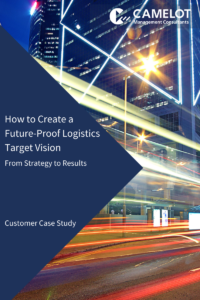In their recent Hype Cycle for Supply Chain Execution Technologies, Gartner analyzes supply chain and logistics technologies in their maturity and on business impacts levels. In this article, we focus on some soon-matured technologies that can be applied in your Transport Management.
Real-Time Transportation Visibility (RTV)
Enabled by Real-Time Transportation Visibility technology, customer demands of e.g. more sophisticated track & trace solutions can soon be satisfied to higher degrees and supply chain managers can take advantage of more powerful supply chain event management solutions (SCEM) which are supported by enhanced forecasting.
Another RTV-enabled but less complex technology is a more advanced Carrier/Shipper Appointment Scheduler. It assists yard personnel planning dock distribution and logistics service provider (LSP) dispatchers to book suitable time slots. The basis is real-time track & trace data which generates precise truck ETAs that is updated regularly to automatically inform yard personnel if other trucks can be handled beforehand to avoid idle times.
Gartner mentions RTV technologies as a key priority, we advise to carefully review your intentions with fostering visibility. What are you going to do with the won information? Are they useful to your business goals? Is it only relevant for better reporting or do you have a profitable business case requiring actual RTV?
Digitized Freight Networks (DFN)
DFN is about digitizing connecting shippers’ freight demand and load capacity offerings of LSP per lane. It shall speed up freight searches and bookings and show real-time freight demand and capacity availability. At first it is going be available for the mode “road”. Air and sea freight might follow later. Gartner expects that maturity will be fully reached in five to 10 years.
The technological foundations for DFN are Web-based Logistics Platforms (WBLP). There are several platforms emerging lately, often developed by fully digital logistics start-ups. Those platforms shall provide an online shopping-like booking experience for multi-modal freight services. It is quite cumbersome for employees to book freight on one of these several platforms just to find the right match (price and time) and then transferring it into the TMS. We estimate that WBLP experience a strong consolidation with increasing specialization as soon as TMS vendors offer mature interlinks connecting shippers and carriers. Current WBLP standard functionalities, allowing also DFN, will become part of the default functionalities of TMS, as we expect.
Supply Chain Convergence (SCC)
A concept which is expected to reach full maturity in up to ten years is Supply Chain Convergence (SCC). In today’s projects we see silos in functional units as one of the key hurdles of significant enhancements. For instance, manufacturing, supply chain planning, supply chain execution (e.g. Transport and Warehouse Management) or customer service historically formed silos of process and IT landscapes. The idea of SCC is to break down those silos and change the perspective from a vertical to a horizontal or even diagonal view across the organization. This shall foster IT and process harmonization in e.g. order-to-cash (OtC) processes. Additionally, due to significant increased transparency along the organization, freight demand-sensing is far better achievable – it becomes reliably predictable. We observe that also SAP with their new S/4 platform supports the progression of supply chain convergence. Processes of functional units are included in one harmonized ERP. This provides potential of significant process harmonization, transparency gains and finally breaking down silos for a more efficient organization.
This predictability and demand-sensing is the main prerequisite of the next technology we would like to take a glance at: Transportation Forecasting (TF). It is the evolution of merged RTV and DFN. TF shall strongly interlink shippers and LSPs to share freight demands and capacity availability by referring to predicted demands. Capacity shortage issues like we see today are expected to intensify in future due to missing drivers and increased traffic congestion. TF can ease this issue by providing shippers more time to plan their transports and carriers to organize enough capacity to a specific date.
How and why you need to review your Logistics Target Vision
What you can learn from above-mentioned technologies is that they only provide full leverage for significant changes in logistics if they are integrated. Therefore, Integrated Transport Management is the key term you must keep in mind when thinking about a Logistics Target Vision. If you think about your current logistics process and IT setup, is it truly and efficiently integrated? How many interlinks must be maintained and are they capable of future logistics requirements? For instance, Transportation Forecasting is an emerging technology with a longer development path ahead. However, some companies already introduced first steps of machine learning (ML) and artificial intelligence (AI) to realize first benefits comparable to TF. Can your processes and IT support ML and AI to realize substantial business advantages?
Even though many technologies need time to be fully matured, you need to include them in your Logistics Target Vision now. Which requirements are necessary, where are your biggest gaps and which technologies to integrate first? In short: a clear target picture is required to create a future-proof logistics roadmap. Only organizations with suitable technologies in place have a chance to generate stable or growing profits. Others will be too busy with firefighting their old-fashioned process and IT setups.
But how do you achieve a forward-looking Integrated Transport Management in your Logistics Target Vision? Deep knowledge and broad market insights are the basics. A profound understanding of future best-practices paired with future technology know-how and overview builds up on that. There is no one-size-fits-all approach and of course your companies own characteristics and pain points must be addressed individually.
CAMELOT’s expertise is the development of an individual step-by-step roadmap for your enterprise: First, you establish transparency on internal and external resources and requirements. Second, a target vision is created including frameworks. Third, project milestones are defined on how you achieve your goal in the long-term and transforming strategic goals into operational results.


